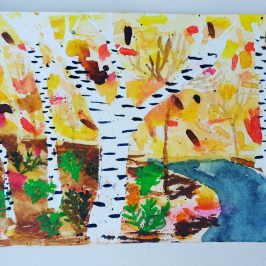What I’ve been learning in my writing class is quite fascinating – all about the writing process. Most of us were trained in the current-traditional rhetorical style, which focuses on correctness and form above all else. The process spends about two seconds inventing ideas, about 90% of your time in drafting and revising simultaneously (which are rivals, which cancel each other out, which paralyze one as a writer). Then about 2 more seconds are spent revising if you’re lucky enough not to be out of time.
The process we’re being introduced to is Writing Process Theory. Here, 33% of your time is spent inventing – not just in your head, but through freewriting and heuristics, brainstorming, etc. In writing. 17% or so of the time is spent drafting! (Drafting is what most people think of when they try to describe what writing is). This is a very forward-moving time where you don’t stop to fix mistakes or anything. Why? Because you would spend so much time perfecting little parts before you have a chance to criticize the overall structure of your work – whether it’s a novel, or a business report, or a poem.
The final 50% of your time is spent revising. The unique part of this revision is that it’s not a holistic approach. You revise in sweeps – for content, then audience, purpose, …superstructure, regional structure, and finally at the very very end, revise for sentences, diction, and mechanics.
Now this is generally eye-opening for people. I definitely see where I’ve been missing out. I tend to be inspired to write either by something I feel strongly about, or in business, seeing a lack or need in my customers. Then I formulate my idea internally, draft it all very quickly, then skip all the revising except my favourite part – diction – my love of crafting words and adding variety. So by this point, I’m in love with my sentences and as if I’m doing major structural revisions. No wonder I get finished and wonder why I have “nothing to say”. I haven’t thought about content, what I’m saying and how I’m going to get my message across and to whom, etc. etc. And since I love my words, I don’t care, I’m just happy that I like my words.
I also made a sort of discovery that answers some of my art/writing dichotomy that you can read about from Oct. 27/04 on this site. I trained myself to paint in a similar vein to my writing style that I learned in high school from a very current-traditional teacher. Correctness was idolized – we were given bonus marks for this errorlessness – in fact I know I was the first student to achieve 100% on a final OAC english exam. Why, not because of my wonderfully inspiring message, but because when it came to diction, I went with words I knew I could spell over choicer words I would have selected had I been in touch with a dictionary. Anyway, I taught myself to paint in the same stilted, correct-focused manner. With watercolour, there is no way to fix an error. I would get very frustrated with the extreme concentration required to make things look right – the first time.
So I’m quite happy to have discovered the painting equivalent to free-writing (through my Emily Carr class). And to be able to examine my own writing process which I am convinced will set me loose from these writer’s block shackles.







Leave a Reply
You must be logged in to post a comment.